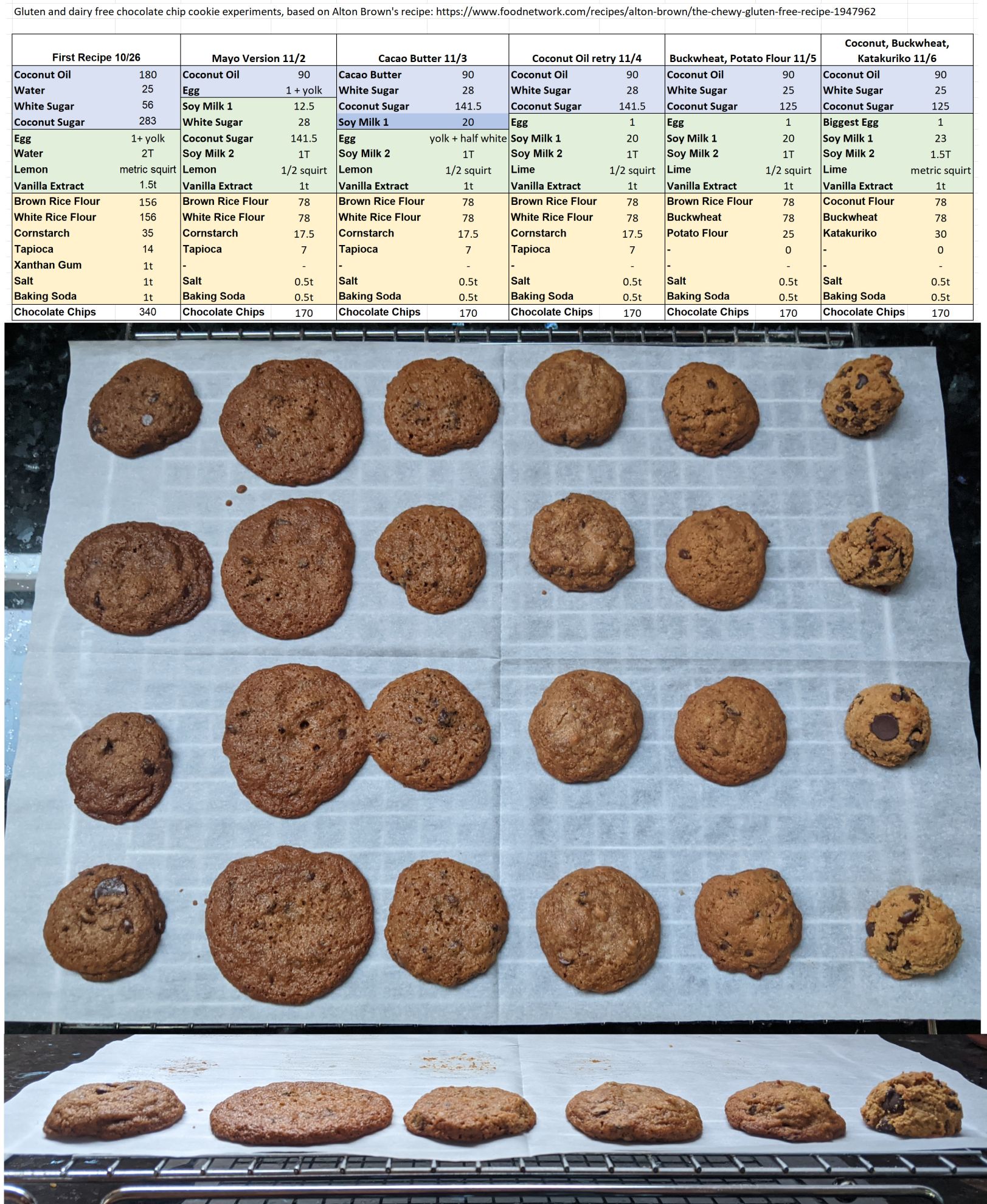Hi! What began as a "why do cookies sometimes get oily" question has turned into a "let's play with gluten free cookie dough" topic 😁.
@Emily440 Thanks so much for that! The original AB recipe uses all brown rice flour. I don't recall why I changed the recipe to be 50/50 brown/white years ago when I was making the vegan variation, but, I did recall doing so which is why it made its way here.
I made a variety of doughs since this thread prompted by discussions, then baked them up to compare. The recipes are provided in the attached table - color coding denotes mixing groups. All with same scoop.
The original batch was a full one, the rest were half-batches, there's only so much room in the freezer! Batches 2-6 used a hand mixer instead of the stand mixer. Baked at 350 + fan (e.g. 375) for 11 minutes. Through discussions with the intended recipient of these cookies, I learned xanthan gum causes irritation, so I excluded it in 2-6.
Here are comments, left to right of the picture:
1. Original dough that prompted this thread. Cookies were oily and randomly spread. I think it has to do with using the stand mixer and over mixing or just not properly mixing bottom of the bowl. Tasty.
2. Tried @teonzo's mayo technique. They spread, and were shiny, but neither oily nor greasy. Super crispy, lacy and Mandelbrot-patterned texture, I really like these. The coconut oil flavor was masked compared to the original. I'm not sure if the spread was because I omitted the white sugar (accident), extra yolk brought more moisture, improperly mixed, or simply nature of the ingredients and technique. I suspect it was the latter because the spreading was consistent and had body to it. The dough was soft and malleable even after several days in the freezer!
3. With arrival of chocolate supplies, I was anxious to try cacao butter instead of coconut oil. I followed technique suggestions here, pouring oil in slowly and mixing with sugar no more than a minute or two. As sugar and oil became uniform, I drizzled in the soy milk, and finished with rest of the wet ingredients. Results were neither oily nor greasy. Everything came together very nicely. I was sorely disappointed with flavor, though, the cacao butter is not good baked, at least, with the combination of ingredients. Unpleasant, almost like eating cookies off hot silpat sheets (you know that plastic, silicone flavor?).
4. Original recipe with the improved technique (slowly pouring oil in, short mixing times, etc). I also used the whole egg. Delicious, if not cloying. After tasting all the cookies and dough batter, the sugar was making me jitter. I think using the whole egg kept the cookies poofier and they spread less.
5. I read @Emily440's suggestion just as I prepared to shut down my computer Thursday evening, and was excited since I had all the ingredients on hand. The cookie recipient has issues with oats as well, so I subbed buckwheat flour***, which gels up kind of like oats, and thought I'd be close enough to her recommendation, except, I thought the amount of potato starch was a bit high so I dropped it a few grams. As I was mixing in the chocolate chips in the last step, I looked over at the packages and realized a mistake I used potato flour, not starch. Oh, well, might as well try. These were delicious. The reduced sugar is better. They did not spread as much, were more cakey and pleasantly moist inside.
6. The cookie recipient loves all things coconut, so decided to try this sub as the last step, and realized I have japanese potato starch (katakuriko), not american potato starch from some attempts to make karaage. It's not clear on the packaging whether the starch was derived from potatos or the water lilly. Coconut flour absorbs a lot of water, but I'm not sure how much more so I made sure to increase liquid items a bit. The resulting taste was interesting, but kind of bland. They have an unusual, almost unpleasant texture of very sproingy meatballs. They also did not spread at all.
Conclusion: for the official batch, I will reduce the sugar, sub in buckwheat for white rice flour, and stick with the 1 egg + yolk, rather than 2 eggs. I might try one more batch replacing the starches and/or potato flour with katakuriko. I could also try splitting the flours three ways with coconut, rice, and buckwheat, or add an extra yolk to the sixth test.. oh boy, too many choices 🤯
Thanks all for the help, hope you've enjoyed my attempts at making some tasty cookies. I enjoyed eating them!
*** I have hulled buckwheat groats on hand, which I rinse, spread out on a paper towel into one layer, and allow to dry overnight. I then grind down to flour (I use an EK43 coffee grinder... don't judge me). These have more moisture due to the rinsing stage, they absorb some water as they dry off, about 5% I think. I do this as a result of the advice here.







